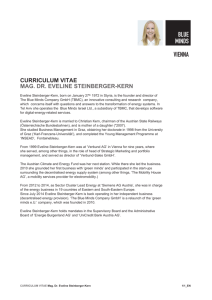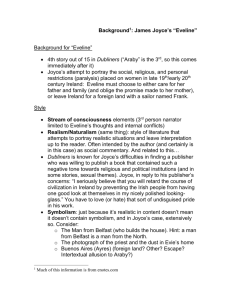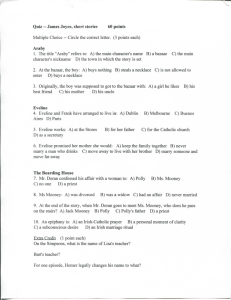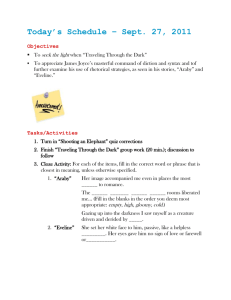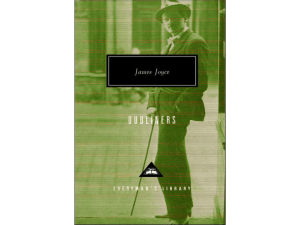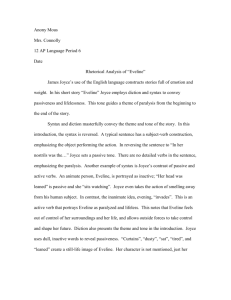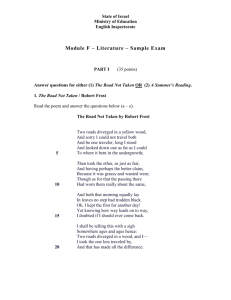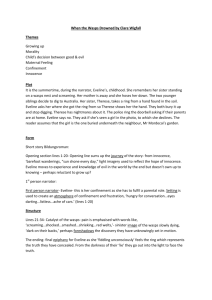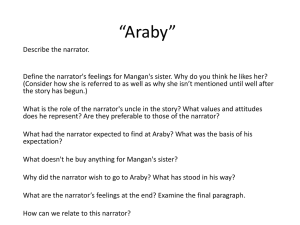Analysing the Paralysis Phenomenon in Eveline by James Joyce
advertisement
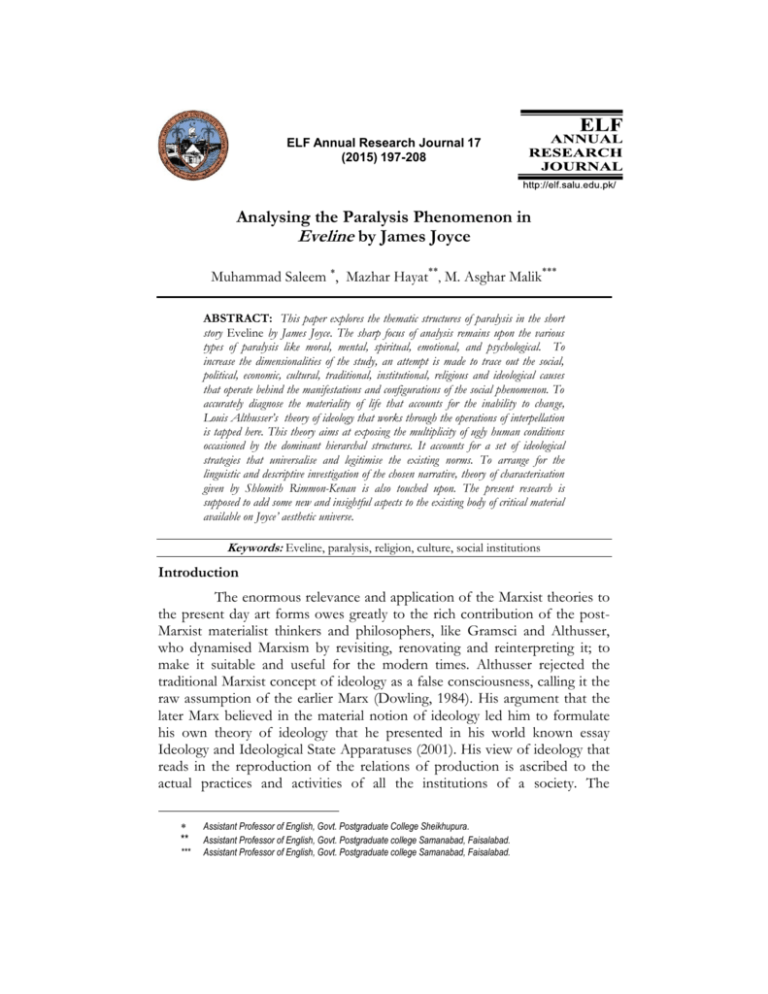
ELF Annual Research Journal 17 (2015) 197-208 Analysing the Paralysis Phenomenon in Eveline by James Joyce Muhammad Saleem , Mazhar Hayat**, M. Asghar Malik*** ABSTRACT: This paper explores the thematic structures of paralysis in the short story Eveline by James Joyce. The sharp focus of analysis remains upon the various types of paralysis like moral, mental, spiritual, emotional, and psychological. To increase the dimensionalities of the study, an attempt is made to trace out the social, political, economic, cultural, traditional, institutional, religious and ideological causes that operate behind the manifestations and configurations of the social phenomenon. To accurately diagnose the materiality of life that accounts for the inability to change, Louis Althusser’s theory of ideology that works through the operations of interpellation is tapped here. This theory aims at exposing the multiplicity of ugly human conditions occasioned by the dominant hierarchal structures. It accounts for a set of ideological strategies that universalise and legitimise the existing norms. To arrange for the linguistic and descriptive investigation of the chosen narrative, theory of characterisation given by Shlomith Rimmon-Kenan is also touched upon. The present research is supposed to add some new and insightful aspects to the existing body of critical material available on Joyce’ aesthetic universe. Keywords: Eveline, paralysis, religion, culture, social institutions Introduction The enormous relevance and application of the Marxist theories to the present day art forms owes greatly to the rich contribution of the postMarxist materialist thinkers and philosophers, like Gramsci and Althusser, who dynamised Marxism by revisiting, renovating and reinterpreting it; to make it suitable and useful for the modern times. Althusser rejected the traditional Marxist concept of ideology as a false consciousness, calling it the raw assumption of the earlier Marx (Dowling, 1984). His argument that the later Marx believed in the material notion of ideology led him to formulate his own theory of ideology that he presented in his world known essay Ideology and Ideological State Apparatuses (2001). His view of ideology that reads in the reproduction of the relations of production is ascribed to the actual practices and activities of all the institutions of a society. The ** *** Assistant Professor of English, Govt. Postgraduate College Sheikhupura. Assistant Professor of English, Govt. Postgraduate college Samanabad, Faisalabad. Assistant Professor of English, Govt. Postgraduate college Samanabad, Faisalabad. 198 M. Saleem, M. Hayat, M. A. Malik / ELF Annual Research Journal 17 (2015) 197-208 institutional practices focus at justifying and legitimising the existing myths, images and behaviours. This Althusserian theory exposes to the reader the operations and strategies which ideology makes use of to let the subordinated remain tied to their present state of slavery. When applied to a piece of literature, it exposes the relevance and worth of the ideological mindset that exerts behind the social structures. To have an adequate understanding of the factors underlying the paralysed life of the central character of Eveline by Joyce, Althusser’s theory of ideology is tapped. It often proves useful to critique a piece of literature from more than one angle; besides providing a larger and broader view, it also leads to the indepth understanding of it. Keeping this phenomenon in mind, the present researchers have added an essay on the art of characterisation, by RimmonKenan (2002) to the theoretical framework of the study. If post-Marxist essay on ideology is supposed to deal with the gaps, contradictions and flat aspects in the existing institutional apparatuses, Rimmon-Kenan’s theory of characterisation believed to render various critical descriptions of the characters in the narrative Eveline. The collaboration of these two modes of appraisal tends to be more appropriate for the deeper analysis of the chosen Joycian writing. This narrative is a part of Dubliners, a collection of short stories that Joyce wrote at the start of his literary career. These writings have been composed in the backdrop of Dublin city which appeared to him as a death site; “that city seemed to me the centre of paralysis” (Joyce as in Peake, 1977, p.1). Irish life that is painted here is just paralysed and this unpleasant phenomenon is the result of the exploitative disposition of dominant religious, patriarchal and other social values. The present study is undertaken to analyse the form and content of the various configurations of paralysis. Literature Review Since the publication of Althusser’s essay Ideology and ideological State Apparatuses, the researchers across the globe have used the post-Marxist materialist theory of ideology to advance their research in the artistic and social domains. Luke (2006) composed a book Louis Althusser that gives a detailed description of Althusser’s materialist ideology; it covers the background, operations and functions of this brand of ideology. He argues that the Althusserian ideology not only restructured the Marxist theories, it also made them attractive and imposing for the current scholarship. It triggers the transition of Marxist philosophy into a new vista that is more realistic, flexible and closer to the human life. Most of the bottlenecks, that the readers feel while studying Althusser’s essay on ideology, are eased by this Analysing the Paralysis Phenomenon in Eveline 199 book. Investigating the Subject’s Identity: The Critical Treatment of the LacanianAlthusserian Dialectic and Subjectivity Formation in James Joyce’s A Portrait of the Artist as a Young Man, a study by Sadjadi (2010), is a great recognition of Althusser’s philosophy of ideology. Sadjadi invents the theoretical framework for his study by introducing the phrase of ‘Lacanian-Althusserian dialect’. He very successfully analyses, with the help of this conceptual frame, the role of psychology and that of ideology in the construction of subordinated life of Stephan, the hero of Portrait of an Artist by Joyce. The Lacanian concepts of the Real and the Imaginary, along with the interpellation processes of ideology, help out the researcher to go for the in-depth analysis of the novel. Saleem (2015) carried out a study in the light of Althusser’s theory of ideology. His technique to make use of Brecht’s theory of V-effects produced excellent results when applied it in the background of materialist ideology. This tool of ideology plays a significant role in the interpretation of the interrogative texts of Brecht and those of Nadeem that he composed for Ajoka theatre. There are many excellent studies by various scholars on Joyce but no one has applied the concept of Althusserian ideology on his narrative Eveline. Hence the present study. Various studies have been conducted to analyse a piece of literature with reference to the technique of characterisation. Elford’s (2011) study is an important example in this regard. The researcher draws on the RimmonKenan’s theory of characterisation along with other theories on the topic. This study adds to the new type of criticism on Apuleius’ novel that makes use of both direct and indirect definition and description of the characters. The other important thing of the thesis is to reach at the patterns of the characters through the various elements of the art of characterisation. Buell’s (2012) study is also a valuable example to use structural approach to the very idea of analyzing the fact that Marxist theories are very important for the analysis and relevant interpretation in modern times and can be referred, discussed and analyzed from multiple perspectives. Buell dissects the central character of the writing by using different methods of character analysis given by theorists like Rimmon-Kenan. While reading this dissertation, we again and again come across multiple strategies that the researcher harnessed to pursue his research project. To keep this research trend go on, the short narrative Eveline by Joyce has been selected. Research Methodology The present study which targets the analysis of paralysis phenomenon is devised to make use of Althusser’s ideology and go for the textual reading of Joyce’ short story Eveline. Following the arguments of Althusser, the ideological role of the specific social institutions aestheticised in the story like religion, family, education, traditions, social mores and M. Saleem, M. Hayat, M. A. Malik / ELF Annual Research Journal 17 (2015) 197-208 200 musts, morality and cultural regressiveness and cynical attitude are interpreted. The institutional network is armed with an ideological syllabus that is programmatically imparted to the social beings. These social institutions address and accost the humans and award them with identity, respect and individuality. They believe that they are as autonomous as the subject in the clause is but reality is this that they are subjected like the subjects to hegemonic hierarchy. The social beings are an ideological construct but they are not aware of this reality at a conscious level. This is called the interpellation process of ideology. The present researchers kept their diagnostic gaze on the character of the institutions, by critically observing the operations and activities that they recommend and carry out. It helped them to clearly perceive the pettiness and worthlessness of the sociopolitical agencies that constitute the ideological foundations of society. While applying Rimmon-Kenan’s theory of characterisation, various elements that take part in the direct and indirect characterisation are critiqued. In direct description of a character, the adjectives and verbs specifically used by the author or his persona are brought under analytical focus. In respect of indirect description of the characteristics of characters, the nature of speech, the type and frequencies of actions, external appearance and evidences from the environment are all considered creatively. The artistic device of foils, modes of analogy between characters, analogous names and analogous landscapes are also studied critically. The research is executed to search out the answers to the following questions. 1. What are the forms and patterns of paralysis in Eveline? 2. How much Althusserian ideology is instrumental for tracing out the sociopolitical causes of the paralysis phenomenon in the Joycian narrative selected for analysis? 3. What is the contribution of Rimmon-Kenan’s theory of characterisation in giving description of paralysis in Eveline? Data Analysis Eveline is an Irish young woman who works in a Dublin shop and loves Frank, an Irish sailor. Fed with her current version of life, she wants to run away with her lover to settle down in Argentina. For this purpose, she goes to the shore for boarding the ship of Frank but ultimately decides to go home to resume her duties as an oppressed and voiceless daughter. The institution of religion, says Althusser, is one of the most important social agencies that successfully interpellate the people to accept the existing societal relations and remain tied to them in their behaviours. This is all ideological. The Roman Catholic Church in Dublin/Ireland has a long history to keep the Irishmen passivised and complacent before the Analysing the Paralysis Phenomenon in Eveline 201 oppressive forces. The catholic Irish people were time and again persecuted by the Protestant English colonisers but they did not make a powerful rebellion. After the devastating period of great Hunger/Famine, the Irish nation, instead of tracing the sociopolitical causes of their backwardness, began to lay strong emphasis on the building of new churches and the regular attendances in the churches. This devotional revolution ideologised the Irish souls to remain distanced from rebellion and sovereignty in the times to come. This is the religious background of Eveline and the other narratives in Dubliners. The complacent and defeatist personality of Eveline is the result of the traditional practices of the church that keeps them allergic to strong reactions. How religion shapes up Eveline is registered in the sentences of the text. She is expected, when at the port, to take initiative but she turns pale and goes for the prayers; she prays ‘to God to direct her, to show her what was her duty’. She ‘kept moving her lips in silent fervent prayers’. The use of the word ‘fervent’ illustrates the ideological role of religion and its ghastly effects on the subjects. There is vehemence and enthusiasm but only in her prayers. There is no fervour and passion in her love life. The all-inclusive character of religion has rendered her bereft of any type of action. Critiquing the phenomenon of oppression, Torchiana labels Eveline “a meaningless sacrificial victim for a religious community lacking charity” (1986, p.75). This brand of religiosity makes one addictive of the familiar, suspicious of the innovative, fearful of the unknown, doubtful of one’s natural abilities and capabilities and allergic to risk. This state of mind and behaviour that accompanies Eveline is well described by Ashbury in his poem The Painter. The Ashburian hero, socialised in the context of the ruling ideologies, has a desire to play his positive role in life but fearful of the social pressures only prays for change. Quite childishly, he believes that prayer, “mere silence” (Ashbury, p.146), is sufficient to make his goal realised. This role of the religion has very dangerous effects on the character. At the start of the story, Eveline remembers a crippled childhood friend called Little Keogh who perhaps metaphorises her own childhood. The paralysis of Little Keogh is the physicalised state of the paralysis Eveline has been suffering. It follows from this analysis that the religionised man is an animal that is born to suffer, endure the suffering and remain with the suffering as a sign of his complacency. The reader is astonished to see through the results of the church ideology. Is religion, as it is constructed in the narrative, is useful for man? Should it be practiced and continued? Doesn’t it produce the uglified human material? These are the questions that cross the mind of the reader during the course of the study of the Joycian story. 202 M. Saleem, M. Hayat, M. A. Malik / ELF Annual Research Journal 17 (2015) 197-208 Bulson (2006) argues that the catholic religion has “an enormous impact on religious, social, and political life” of the Irish nationals and resultantly they have “learned to oppress themselves” (p.33). The church and patriarchy in collusion with each other effectively controlled the Irish family setup in the earlier decades of the previous century. Consequently, the human material is demoralised. If the father of Eveline was not careful of his daughter, the mother was not much different in this regard. Her catholic female parent never encouraged her daughter to take initiative and make a rebellion against the crippling character of the traditional family institution. Rather, she takes a promise from Eveline to ‘keep the home together as long as she could’. Under the influence of the religion, the central character continues to remain adherent to the promise and in this way her life is paralysed i.e. she cannot elope with Frank. While commenting on the theme of paralysis, Tolentino (988) says “nothing but family bonds hold her back” (p.74). For the mother, the home was a hospital and the daughter is a housekeeper there. But for the father, both the women are the object of his patriarchal violence. The father figure brutalised his wife by turning the marriage wedlock into an inferno for his life partner and ultimately she was paralysed, all the time riveted to the bed. He used to carry a stick with him to bring Eveline and her siblings from the playground to home in their childhood. Now, when she is a grown woman, who does a job in store to meet the expenses of the house, he calls her brainless and threatens to beat her physically for her sins that she did not perform. What are the results of the familial and patriarchal aggression on Eveline? Love is always considered a healthy passion which has been bulldozed. She loves Frank, sees dreams of running from home and settling along with her husband away from Dublin but she does not board the hip of the beloved sailor. She seems physically paralysed. She wants to ‘explore’ the new world but she has no courage and energy left to actualise this dream. While illustrating the devastating role of the ruling ideologies in the narrative under dissection, Dolch (1969) says “change is already beyond her capacity and fills her with a crazy fear which mistakes salvation for destruction” (p.99). In fact, her experience with her male father has made her believe that the Irish male is just the coloniser of the female. To migrate from the known to the unknown is an impossible task. Doesn’t Eveline prefer the dead to the live? Isn’t she bereft of the spirit of life and love? Does she learn any lesson from her life? Isn’t she successfully interpellated subject? How she is different from an animal? Isn’t she emotionally, morally, psychologically, physically, verbally, socially and politically paralysed? These are the questions that jump to the mind of the reader in the perusal of Eveline. Analysing the Paralysis Phenomenon in Eveline 203 Contribution of narratology for understanding a piece of literature is always marked. The science of narrative holds that a character stands for a network of character-traits that are linked with the character-indicators spread along the text-continuum. Direct definition is one of these textual indicators. There are many pieces of direct definition in Eveline. Joyce, while describing Eveline’s character, says ‘she was tired’. At first sight, it seems a reference to her physical stoppedness only but soon the reader comes to know that it is also a reference to her jammed up human and social existence. She is leaned against the window curtains and the odour of cretonnes rushes into her nostrils. These images adopt dangerous and graphic dimensions, when the reader goes to the line ‘she sat at the window watching the evening invade the avenue’. One is reminded of the starting lines of Eliot’s poem The Love Song of J. Alfred Prufrock. The Eliotique hero addresses himself thus: “Let us go then you and I/When the evening is spread against the sky/Like a patient etherised upon a table” (Eliot, p.9). Here, in both the cases, the central characters are clogged up souls to embody the sense of hemiplegia. Eveline, like Prufrock, is the etherised soul; she is conscious of her inadequacies and non-entity but not critically and diagnostically. Here, in both of the writings, the evening that is constantly approaching/spreading is the symbol of the vehement encroachment of death. The ‘avenue’ under attack stands for human life. What is important to notice is that the characters are the victim of the tragedy of life but they are unable to go for the remedial measures to save their skin. This is their paralysis: the vey self is moth eaten, rusty and irreparable. The reader is surprised to notice the mental paralysis of Eveline. She is a true sufferer of the earth that remains a flat character throughout the story. There are normally two types of activities of literary characters: onetime actions and habitual ones. Rimmon-Kenan (2002) believes that “habitual actions tend to reveal the character’s unchanging or static aspect, often having a comic or ironic effect” (p. 61). Eveline also falls to this category of characters. Her paralysis is betrayed through her automatized behaviours and her thickness with the pastness. ‘She has dusted once a week for so many years’ clearly shows that Eveline is ready and secretly happy to exist in her father’s house like an animal. She is habitual of remaining sitting at windows, habitual of remembering her promise to the mother, habitual of inaction, habitual of a variety of violence from her father and habitual of conformity in all aspects of life. It is another type of paralysis linked with her. There are few physical movements of this character mentioned in the narrative: she used to visit the playground in her childhood; she worked in a store; she went to the harbour to elope with Frank ad soon came back. The perceptive eye of the reader easily comes to the conclusion that the destination of each of her movement is her parents’ house. Inertia is the 204 M. Saleem, M. Hayat, M. A. Malik / ELF Annual Research Journal 17 (2015) 197-208 inscribed in her movements. She remains a centripetal force and never tries to be the centrifugal force which is necessary to be a dynamic figure. Speech of a character is usually in two modes: participation in conversation and the silent activity of the mind. In both cases, speech indicates the contents of the self of a character. Leech (1989) posits that the elements of a linguistics construction reveal the size, depth and direction of the mind of a character. Speech and action often work like the mode and spirit of cause and effect. What is the world view of the character, the ambition of the character, the energies of the character all is exhibited usually through his parole. As far as the case of Eveline is concerned, she does not produce even a single utterance. Here absence of speech is not due to the linguistic poverty, it is the sign of lack of critical, rebellious and reactive thinking on her part. She exists but certainly does not live in the world. Her distance from speech creates a cleat cut pattern about her and it adopts pragmatic sense. The statement that she kept her lips moving but did not say a word well emphasizes her character. She has love and desire for Frank but no struggle which is essential in such matters. Frank’s single word speech ‘come’ tells us the sharp contrast between an active and passive character. Following Prince (1982), it can be said that the narrator in the story under discussion is covert whose intrusiveness in the story is remarkable. The sharp observation and interpretive sense of this narrator is evident from the words that he used with reference to Eveline and other characters of the story. Verbs used to describe various aspects of Eveline are mostly at a distance from motion like ‘sat’, leaned’, ‘seemed’, ‘knew’, ‘was always down’, and ‘prayed’. The other category of words is that of infinitives like ‘to throw’, ‘to weary’, ‘had to rush’, to explore’, ‘to go away with him’. The use of infinitives sometimes is made in literature to stress the inability of a character to rise up to the occasion. Same is true with reference to Eveline: ‘she had consented to go away, to leave her home’ and ‘now she was going to go away like the others, to leave her home’ are the examples of her static position. The narrator always uses infinitive to describe her future elopement with Frank: ‘she was going to go’, ‘she had consented to go away, to leave’ and ‘she was to explore’. All this shows that Eveline will remain away from real action to leave her father’s house. The adjectives are also reflective of the passivity of the character: ‘tired’, ‘undesirable life’, ‘very kind’, ‘open hearted’, ‘passive’, ‘helpless animal’. Past and future are always a warm refuge for the shirkers of work. It is relevant to Eveline also. Some expressions emphasise the pastness of the past tense: ‘heard’, ‘bought’, ‘dusted’, ‘never found’, ‘remembered’, ‘deepened’. The other linguistic device to judge a character is the use of words that show his propensity to some phenomenon. And here the routine expressions are ‘people passed’, ‘there used to be’, ‘used to play’, ‘her father Analysing the Paralysis Phenomenon in Eveline 205 used to’, ‘used to squander the money’, ‘used to visit, ‘continued to sit by the window’, ‘to keep the home together’ like vocabulary. It symbolises the settled way of the character. The most frequent word in the story is ‘death’. What often strikes the reader is the use of words which point to the theme of motionlessness in the life of Eveline. Certainly, the narrator of the narrative is not a reliable one as he again and again prepares the mind of the reader about Eveline’s leaving of her father’s house but it does not materialise in fact. But if we look at the picture from the other angle, this ironic mode is consciously used by the narrator to make the reader understand her pitiable state in which she is and stir him to laugh at it. This is a narratological technique to expose the dilemma, inertia, of Eveline. The narrator also uses this device to astonish the reader to look into the ideological causes that make Eveline comply with the demands of her half alive, half dead phenomenon of life. Findings The investigation of James Joyce’ short fiction Eveline led to some significant findings. First, the application of Althusser’s materialist ideology proved very successful in determining the role of social institutions like religion, morality, family, patriarchy and politics in the construction of social beings. Eveline, the central figure of the narrative, is paralysed by the institutional practices of the Irish society of the time. The thrust of institutional practices turns her into a cripple: she lacks energy to run away with her lover; she is too weak to resist the cruel patriarchal gestures of her father that strip her of her individual independence; she scrupulously acts on her mother’s advice to continue to pull on the house at any cost. She herself has to earn money to meet the expenditures of her patriarchal father’s household but she does not make a rebellion The paralysed Eveline is an animal that is lying helpless in the ideological cage. Second, application of Rimmon-Kenan’s theory of characterisation enables us to notice various forms of Eveline’s paralysis: physical, emotional, moral, social and personal. Even love which is considered a very strong passion of man miserably fails to mobilise the ideologised woman. The lover on the boat, which is soon to leave the Irish coast, continues to call her to elope with him but she remains locked to the iron railings: ‘she set her white face to him, passive, like a helpless animal. Her eyes gave him no sign of love or farewell or recognition’. These various forms of paralysis of the central character help us to recognize the role of the ideological interpellations/institutions that justify the dominant structures and let them exploit the masses. Apparently, these social agencies help out the social animals but in reality they train them to contribute to the going on statusquo in the society. 206 M. Saleem, M. Hayat, M. A. Malik / ELF Annual Research Journal 17 (2015) 197-208 Conclusion The analysis of data and consequent discussion prove that the application of Althusser’s concept of ideology and Rimmon-Kenan’s theory of characterisation impart new dimensions and interpretations to the Joycian narrative Eveline. The narratological devices, like analogy of characters, speech, action and direct definition that were employed for analysis proved very helpful to foreground the manifestations and forms of the paralysis phenomenon in the story. They also were instrumental in distinguishing the different types of paralysis like physical paralysis, moral paralysis, psychological paralysis, social paralysis and environmental/cultural paralysis. The application of Althusserian ideology is a political tactics. It investigated the social, political, religious, patriarchal, familial and other social institutions with reference to their ideological practices that interpellate the social subjects; it also defamiliarised the ideological constructs that are used for the legitimisation and universalisation of an oppressive mindset. For example, it laid bare the political role of Roman Catholic Church in Ireland in turning the people paralysed, defeated, complacent and immobile. The Althusserian ideological theory, on the one hand, critiqued the sociopolitically oppressive role of the institutional agencies of the historic times and, on the other hand, divulged the repellant social constructs produced by the dominant hierarchal hegemonies. Analysing the Paralysis Phenomenon in Eveline 207 References Althusser, A. (2001). Lenin and philosophy and other essays. New York: Monthly Review Press. Ashbury, J. (2003). The painter. Lahore, Pakistan: College Book Depot. Buell. S. D. (2012). The characterization of Aaron: Threshold encounters in Exodus, leviticus, and numbers. (Doctoral dissertation). Department of Religion, Baylor University. Bulson, E. (2006). The Cambridge introduction to James Joyce. Cambridge: Cambridge University Press. Dolch, M. (1969). Eveline. In James R. Baker & Thomas F. Staley (Eds.). James Joyce’s Dubliners: A critical handbook. Belmont, Wadsworth: 96–101. Dowling, W. C. (1982). Max, Althusser, Marx. New York: Cornell University Press. Elford, J. C. K. (2011). Characterization in Apuleius’ Cupid and Psyche episode. (Doctoral dissertation). McMaster University. Eliot, T.S. (1963). Selected poems. London: Faber & Faber. Goldstein, P. (2005). Post-Marxist theory: An introduction. State University of New York Press. Hawkes, D. (2003). Ideology. New York: Routledge. Joyce, J. (2005). Dubliners. San Diego: ICON Group International, Inc. Leech, G. N. (1989). A linguistic guide to English poetry. Hong Kong: Longman Group UK Ltd. Luke, F. (2006). Louis Althusser. London & New York: Routledge. Magda, D.T. (1988). Family bonds and bondage within the family: A study of family ties in Clarice Lipsector and James Joyce. Modern Language Studies, 18(2), 73–78. Peake, C. H. (1977). James Joyce: The citizen and the artist. California: Stanford University Press. Prince, G. (1982). Narratology: The form and functioning of narrative. Hague: Mouton. Rimmon-Kenan, S. (2002). Narrative fiction: Contemporary poetics. London & New York: Routledge Sadjadi, S. B. (2010). Investigating the subject’s identity: The critical treatment of the Lacanian-Althusserian dialectic and the subjectivity formation in James Joyce’s A Portrait of the Artist as a Young Man (Doctoral dissertation). Available from Open Research Exeter database, ID: 10036/112123. Retrieved from https://ore.exeter.ac.uk/repository/handle/10036/112123 208 M. Saleem, M. Hayat, M. A. Malik / ELF Annual Research Journal 17 (2015) 197-208 Saleem, M. (2015).Theatre for change: A socio-political comparative study of Brechtian and Ajoka theatre. Department of English, International Islamic University, Islamabad. Torchiana, D. T. (1986). Backgrounds for Joyce’s Dubliners. Boston: Allen & Unwin.
